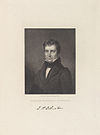
North Dakota's at-large congressional district is the sole congressional district for the state of North Dakota. Based on size, it is the eighth largest congressional district in the nation.

From 1993 to 2023, Montana was represented in the United States House of Representatives by one at-large congressional district, among the 435 in the United States Congress. The district was the most populous U.S. congressional district, with just over 1 million constituents. It was also the second-largest by land area, after Alaska's at-large congressional district, and the largest by land area in the contiguous United States.
Vermont's 1st congressional district is an obsolete district. Vermont currently has one representative to the United States House of Representatives, elected statewide at-large. Until 1933, however, the state used to have multiple seats spread out into geographic districts. During that time, the first district elected its own representative.
Louisiana's 1st congressional district is a congressional district in the U.S. state of Louisiana. The district comprises land from the northern shore of Lake Pontchartrain south to the Mississippi River delta. It covers most of New Orleans' suburbs, as well as a sliver of New Orleans itself.
Louisiana's 2nd congressional district contains nearly all of the city of New Orleans and stretches west and north to Baton Rouge. The district is currently represented by Democrat Troy Carter. With a Cook Partisan Voting Index rating of D+25, it is the only Democratic district in Louisiana.
Louisiana's 3rd congressional district is a United States congressional district in the U.S. state of Louisiana. The district covers the southwestern and south central portion of the state, ranging from the Texas border to the Atchafalaya River.
Louisiana's 4th congressional district is a congressional district in the U.S. state of Louisiana. The district is located in the northwestern part of the state and is based in Shreveport-Bossier City. It also includes the cities of Minden, DeRidder, and Natchitoches.

Louisiana's 7th congressional district was a congressional district in the U.S. state of Louisiana located in the southwestern part of the state. It last contained the cities of Crowley, Eunice, Jennings, Lafayette, Lake Charles, Opelousas, Sulphur and Ville Platte.
Louisiana's 8th congressional district was a congressional district which was created in 1913 and eliminated in 1993 after Louisiana lost its eighth congressional seat in the 1990 U. S. census. For its entire existence, it was based in Alexandria and included much of the north-central part of the state.

South Dakota's at-large congressional district is the sole congressional district for the state of South Dakota. Based on area, it is the fourth largest congressional district in the nation.
From its statehood in 1816 until 1823, Indiana was allocated only one representative, who was elected at-large. During the 43rd Congress, from 1873 to 1875, Indiana elected three of its thirteen representatives to the United States House of Representatives at-large from the entire state.
When Arizona became a state in 1912, it was allocated a single seat in the United States House of Representatives, whose member was elected at-large, or statewide.
At different times in its history, Washington elected one or more U.S. representatives at-large statewide.

Michigan's 15th congressional district is an obsolete congressional district in the state of Michigan.
Michigan's at-large congressional district may refer to a few different occasions when a statewide at-large district was used for elections to the United States House of Representatives from Michigan.
During the first twenty-four Congresses, Connecticut elected all its representatives in Congress from a single multi-member Connecticut at-large congressional district.
In 1913, Oklahoma was apportioned three additional congressional seats. For just the 63rd United States Congress, those three members represented the state at-large.
From its admittance as a state in 1890 to 1913, Idaho was represented in the United States House of Representatives by one at-large representative. After the 1910 census Idaho was awarded a second seat starting with the 63rd Congress in 1913. However both seats continued to be elected at-large on a general ticket until the election of 1918. Since that year the state has allocated two districts for its representatives.
The State of Colorado was represented in the United States House of Representatives by one member of the House, elected at-large from 1876 until 1893 and from 1903 until 1913, and by two members at-large from 1913 until 1915. Since the 1914 elections, all members from Colorado have been elected from congressional districts.
On three occasions in New York history, some members of the United States House of Representatives were elected statewide at-large. This was due to an increase of the number of representatives after the previous federal census, and the failure of the State Legislature to re-apportion the congressional districts in time for the next election.







